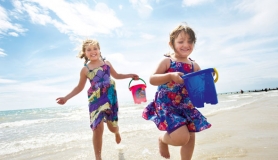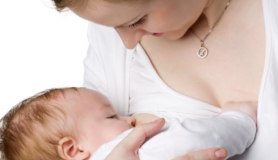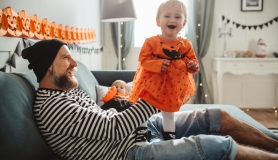As I stood outside my daughter’s bedroom, listening to the sounds of her muffled crying, a few silent tears escaped down my cheek. With a heavy heart, I gently knocked to ask if I could come in. After closing my eyes and taking a deep energising breath, I went in. My daughter’s face was wet with tears and her breath was fast and shallow. I noticed how she vigorously rubbed at her fingers like there was a stain on them that needed to be rubbed off at all costs. These were just a few signs that my usually carefree 9-year-old daughter was feeling extremely anxious.
“What is up sweetheart?” I would ask, however, I already knew the answer as this was a regular occurrence in our house. Especially after the return to normal life following the many months of lockdowns and isolations during the pandemic.
“I’m worried about tomorrow. I’m worried my teacher is going to move my seat again and I don’t know who I am sitting next to” she would answer. I took her hand in mine and offered her the warm comfort of my embrace. But, I knew that I couldn’t stand by and just watch my little girl crumple with the weight of this worry. She had become a shadow of her former self, she didn’t want to go to school and her relationships with friends had become strained and distant. The anxiety, worries and thoughts of what ifs seemed to be consuming her sweet little mind and I saw the life and soul of my free-spirited girl become withdrawn and dampened.
Immediately, my mama bear came out. I wanted to rescue her and take all of those feelings away! I wanted to run to that teacher and tell him to stop moving my daughter around the classroom and keep her in one spot next to her ‘safe people’, the two friends she felt comfortable with. But, deep down I knew that that wasn’t the answer.
But what could I do instead? I felt powerless. And I’m not alone. The UK Government reported that after the covid-19 pandemic, childhood mental health issues have seen rates rise for children aged between 6 -16 years old from 11.6% in 2017 to 17.4% in 2021.
Helping an Anxious Child
Through my work as a registered integrative and creative play counsellor here in the UK, I already knew of the underpinning theories of what I may do if an ‘anxious child’ came into my playroom. But as a parent to an ‘anxious child’ how could I help her, without turning into her therapist? As a counsellor you are taught that one of the most important parts of ‘therapy’ is the therapeutic relationship, so how can we as parents put that into our everyday lives to help our anxious children?
Firstly, I needed to remember that my daughter’s anxiety was something her body was feeling. Where does her anxiety come from?
Anxiety can be a normal function of our body to keep us safe from threats. Dr S Porges’ polyvagal theory is a solid basis for understanding anxiety and its function and effect on our nervous system. The polyvagal theory explains that our automatic nervous system works subconsciously to control our internal environmental conditions.
3 States of Being
The polyvagal theory states that we have three different modes of being and will adjust automatically between the three states, a bit like a ladder. At the bottom of the ladder is the green zone, the Safe and social state, also known as rest and digest. In this state we feel safe, can connect with others and are open to curiosity and joy. The next state up on the ladder is the red zone, flight or fight. In this state, our body is alerted to threats, and we may feel anger, frustration, anxiety and fear. We may start to see physical symptoms such as a fast heart rate, tense muscles and faster shallow breathing. The last state at the top of the ladder is the blue zone. This is our freeze, fawn or shut down state. In this state, things may have become overwhelming. During this state the body starts to conserve energy, you may feel numb, have a sense of hopelessness, tense muscles and may feel detached from the world.
These systems work together to respond to safety and danger within our external environment. When our body perceives something as a threat it will respond accordingly to keep us safe. These reactions to safety and danger become the precursors to how we view our internal and external world.
So, in acknowledgement of this, some anxiety is normal and is an important function, as it is our body’s normal response to threat. However, it can become maladaptive when our body perceives things that are not a threat, as a threat; thus making us hyper-vigilant and feel unsafe. If we don’t ‘feel safe’, then our body can get stuck in this red state for longer periods, rather than moving between the states effectively. This is when those anxieties start to interfere with other parts of our child’s life and we see our children’s mental health start to suffer. So, in order for our body to come back down into the green zone, our body needs to feel safe.
Creating safety
So, how can I help my daughter feel safe and start to bring her down from this heightened state? Dr Bessel Van Der Kolk, trauma specialist once stated that “the parent-child connection is the most powerful mental health intervention known to mankind”. He also states in his book the body keeps the score “that being able to feel safe with other people is an important aspect of mental health”.
So how do we do that? How do we make our children feel safe when their world around them may feel unsafe? As Dr S Porges points out, children don’t yet have the ability to self-soothe or self-regulate their emotions by themselves. Children need to borrow our nervous system in order to learn how to do that. This is called co-regulating. Co-regulating according to the polyvagal theory, is the sending and receiving of feelings of safety. It is the connection that happens between two nervous systems which regulate the other and is a primary need developed to facilitate survival. As humans, we are hardwired to seek interpersonal connection.
The 4 R's of Compassionate Parenting
When I co-regulate with my children I use an adapted version of Dr M Coyne’s compassionate parenting. I use the 4 R’s, Reflect, Regulate, Relate and Reason. By using the four R’s, I can help my daughter feel safe, regulate her nervous system and in turn empower her to learn the tools she needs to become resilient in the face of anxiety.
Let me explain the 4 R’s in more depth:
Reflect – How is my body feeling right now? What emotions am I feeling? Am I regulated enough in order to be emotionally available for my child? Self-care for us as parents is vital, as we can’t help our children to co-regulate if we are unable to be fully present. Pouring from an already depleted tank isn’t going to leave much juice in the tank to give if we are needing that juice to regulate ourselves. For me, I find taking some time out to do the things that give me joy like crochet, a relaxing bath and meditation helps keep my tank full and replenished. It is also important to ask yourself “what can I do to help my body feel calm in this moment?” I use breath work, slow deep breaths through my nose and out through my mouth or my version of the grounding technique - 5 things I can see, 4 things I can hear, 3 things I can feel, 2 things I like to taste and 1 thing I like to smell. Doing this helps to regulate my emotions and calm my body and nervous system enough so that I can give my daughter my full presence.
Regulate – Soothing your child. This anchors them to you and your nervous system, helping them to feel safe and soothed through your presence and affection. It says, ‘I am here for you, you are not alone’. Body to Body – What is my child’s body feeling right now? What does their body need right now? It may help to find a few sensory calming strategies, these can soothe your child and their nervous system when they are in the red zone. The sensory strategies I use for my daughter are, listening to calming music whilst I stroke her hand, or me singing softly to her whilst we have a hug. This may look very different for your child. Your child may need less stimulation, or if they are in the blue zone, they may need something upbeat to stimulate the nervous system. For some children, it may be that your presence alone is enough to help calm that red zone. This is about trial and error and finding what works for you and your child.
Relate - Helping your child feel they are understood and are not alone. What is going on inside your child’s mind? This comes in the form of ‘attuning’ to your child’s thoughts and feelings. This is done through using active listening and empathy.
I may say, ‘I hear that you’re feeling worried about the possibility of changing seats at school tomorrow. I can understand how not knowing who you are going to sit next to may make you feel worried and your body feel stressed and wobbly, I am here for you’. Try to use their words and repeat them back to them. This makes your child feel heard and understood.
Reasoning - Empowering your child to work with you to find tools and solutions which they feel may help them. Try not to get this confused with rescuing your child. If we give them solutions or try to ‘fix’ their issues then we miss the opportunity for them to learn the tools they need to become resilient. Try asking, ‘How do you think you can deal with this situation in the future?’ ‘What do you think would be a good thing to try?’ Sometimes they may come back with ‘I don’t know’ and that’s perfectly ok. It may be that their nervous system is still too heightened for the thinking part of the brain to be able to come up with solutions. How I respond to this is ‘that’s ok, it can be hard to think of things that may help, maybe once you’re feeling more able, we can brainstorm some ideas another time’.
Strengthening Relationships
These 4 R’s when done consistently, over time can strengthen the parent-child relationship and form a solid basis of safety. After using the 4 R’s with my daughter, I saw a shift in her demeanour. By showing my daughter compassion and co-regulating her anxieties consistently using the 4 R’s, she was able to start linking the underneath reasons as to why she was anxious. The underneath causes we discovered were from the pandemic. Her body had learnt through repetition and experiences that we had to keep away from people, that being near others out of our immediate circle was ‘unsafe’. This meant her body perceived some people as a threat. She also spoke about how she felt a lack of control over her environment.
Over time, slowly but surely, as I showed up for her consistently, her body was reminded that I was safe, relationships with other people were ‘safe’. Her body started to calm its reaction and she became more resilient in the face of change and lack of control over the school environment. She became less anxious, is needing me less in the evenings before bed, is going into school happier and as her body shifts into the safe and social green zone, she has started to have better relationships with friends; as she isn’t pushing them away as much. We’re still not 100% there yet, as we navigate the ever-changing paradigm of friendships. However, her resilience and feelings of self-belief have vastly improved and our relationship is stronger than ever. For that, I am truly thankful.
Disclosure: This way of parenting can help all children improve their mental health and wellbeing, however, if things seem to be worsening or your child is not coping, then it is important to seek further guidance from your child’s doctor or through an agency who specialise in children’s mental health.
Kirsty Hartgrove MBACP is first and foremost a mum to 5 children between the ages of 3 - 12 and a wife to Luke, her supportive husband. “Along with our dog rusty and our cat Bailey we live in a bungalow in semi-rural Suffolk, England. Three of our children are neurodiverse and I myself am also neurodiverse. As well as caring for my children I am an integrative and creative play therapist registered with the British Association for counselling here in the UK. I am passionate about the mental health of both children and parents. From this passion, I set up my own business the happy parent and child initiative because of the past experiences I went through with my own children. My aim is to create happier parents and children by creating stronger parent-child relationships through self-exploration, creativity and play.”







